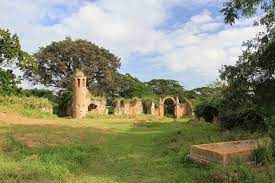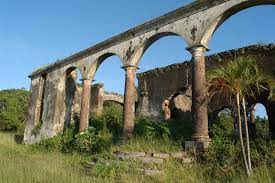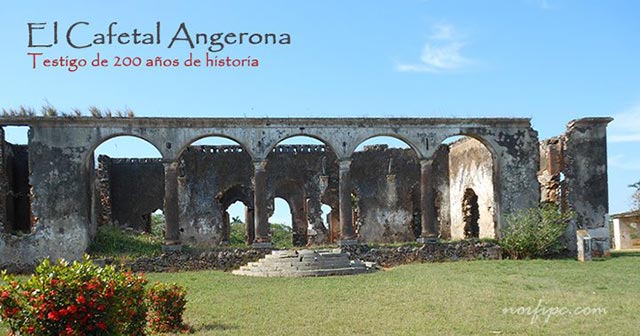CAFETAL ANGERONA, ARTEMISA, CUBA: SIMBOLO DE NUESTRO PASADO NACIONAL E HISTORIA DE UN BELLO AMOR. PHOTOS
Las ruinas del cafetal Angerona se encuentran situadas en el Km 5 de la carretera que une el municipio de Artemisa con Cayajabos, en la provincia Habana. Su dueño fue un emigrante alemán, Cornelio Souchay, quien adquirió la primeras tierras en el año 1813, por un precio de 14 000 pesos.
El Cafetal Angerona fue una prospera plantación de café, con las instalaciones para el procesamiento del grano y una enorme hacienda, mantenida mediante el trabajo de negros esclavos. Su dueño vivía en una casa señorial situada en el frente de la hacienda.
Todo el lugar poseía una gran belleza, de la que fueron testigos muchos visitantes famosos en aquel tiempo. Según la historia la mansión y el cafetal fueron visitados por artistas, pintores, grabadores, escritores y hombres de negocios. Entre ellos estuvieron Cirilo Villaverde, José Antonio Saco, José de la Luz y Caballero, Ramón Zambrana y su esposa Luisa Pérez de Zambrana, el reverendo norteamericano Abiel Abbot, el escritor Ingles Charles Augustus Murray y el madrileno José Jacinto Salas y Quiroga; el paisajista Alejandro Moreau, el fotografo alemán Cohner, entre otros.
HISTORIA DE UN BELLO AMOR
Cornelio Souchay había llegado a Cuba a principios del Siglo XIX. En La Habana conoció a Úrsula Lambert, morena haitiana nacida libre que también había llegado a la mayor de las Antillas junto a sus padres y su amo, el colono Lambert, huyendo de la guerra producida por la revolución en Haití. En 1815 Úrsula comienza a trabajar con Cornelio y en 1822 llega a Angerona. Ambos compartieron intereses económicos, financieros y organizativos del cafetal.
A pesar de los prejuicios sociales y raciales de la época, vivieron un intenso amor. Fueron la “comidilla” de los comentarios sociales de aquel entonces.
Tal parece que se debe a la influencia de la morena los buenos tratos que recibían los esclavos en el lugar. Se dice que enseñaba a las esclavas labores de costura y el trabajo doméstico. Debido a su iniciativa se construyó una enfermería y la casa de los criollitos, donde se cuidaba a los niños.
Cornelio Souchay murió en 1837 y fue enterrado en el cementerio del cafetal, que se encontraba en la parte posterior, detrás del rio.
Nunca se casó ni tuvo hijos, su heredero fue un sobrino. Úrsula aunque no era esclava, nunca podría llegar a ser la dueña de Angerona.

Una escena de la Pelicula Cubana “Robles de Olor” con la Historia del amor entre Ursula y Cornelius en Angerona.
Cornelio en su testamente le dejo 20 000 pesos pagaderos en cuotas anuales, de los que solo recibió una pequeña parte debido a la bancarrota de la hacienda.
Se fue del cafetal después de la muerte de Cornelio y se estableció en La Habana, en el barrio de La Merced, en la Habana Vieja, donde murió en 1860 a los 70 años.
Le rindió luto a Cornelio toda su vida. Nunca se casó, ni tuvo hijos.
Se dice que ella y sus relaciones fueron las ultimas frases de Cornelio antes de morir.
EL ESPLENDOR DE TODA UNA EPOCA PASADA
Angerona alcanzó a ser, en la primera mitad del siglo XIX, la más importante plantación cafetalera del occidente cubano y la segunda de la Isla. En ella convivían unos 450 esclavos, cifra colosal para una sola plantación, y el sistema de organización laboral que imperaba era muy distinto al del resto de la colonia.
Instalaciones hidráulicas suministraban por gravedad agua al cafetal. Un aposento convertido en ropero guardaba en 300 gavetas, numeradas e identificadas con el nombre de un esclavo y su compañera, la ropa hecha a la medida que cada primero de enero se les entregaba.
Más de 25 instalaciones u objetos de obra llegaron a formar parte del conjunto arquitectónico de la plantación: la casa de vivienda; el local con un molino de pilar café, molino de moler maíz y molino de pilar ladrillos; una fábrica de mampostería y azotea con un molino de aventar y otro de apartar; una casa de mampostería y tejas planas, aledaña a la de vivienda; otra casita inmediata a ésta; una caballeriza sobre horcones de quiebrahacha y tejas planas; una casa para maíz sobre 57 horcones de quiebrahacha y tejas planas; una enfermería de dos altos; seis piezas de bóveda; una casa de mampostería donde se colocaban los mecánicos, la sierra y las maderas; una casa con divisiones para animales; una casa de mampostería y tejas para operarios y el mayoral, al lado de la herrería; un tejar sobre 31 horcones de quiebrahacha, cubierto de tejas planas, con su máquina de amasar barro y demás utensilios; un horno para cocer tejas; siete bóvedas contiguas a los aljibes; siete bóvedas de ladrillos para casitas de perros; 18 bóvedas chicas para el uso de las lavanderas; y el poblado de los esclavos.
En Angerona existía el llamado barracón de patio. Don Cornelio había creado un poblado para los esclavos donde, circundando una plaza, se encontraban 27 chozas, un torreón con una campana, un común (duchas y sanitarios), una cocina, habitaciones para el mayoral, calles, todo cercado por muros, piedras y una sola puerta de hierro. Las chozas medían 17 metros cuadrados, sus paredes eran de embarrado y techos de guano, y se encontraban separadas unas de otras por un espacio de dos metros, divididas por una cerca de altas estacas. En cada una convivían dos familias.
RESEÑA DE LA EPOCA
El amo no permitía que los esclavos trabajaran de noche. En verano, por el día, les daba tres horas de descanso y en invierno hora y media. Diseminados por la finca había 30 cobertizos donde podían guarecerse en caso de lluvia.
24 años después de fundado, el cafetal tenía casi 40 caballerías, 625 519 cafetos, 45 000 hoyos de plátanos, 200 árboles frutales, 1 000 palmas paridoras, árboles de madera preciosa y otros sembrados menores, entre ellos un pequeño cañaveral.
Cornelio Souchay murió en La Habana en 1837 y según la certificación de defunción asentada en los libros de la iglesia de Cayajabos, fue enterrado en el cementerio del cafetal. Su sobrino, Andrés Souchay, uno de los albaceas de Don Cornelio, se instaló entonces en Angerona junto a su esposa Bertha Hesse Weyman, pero no logró mantener el auge de la plantación, independientemente de que en la Isla la caña de azúcar comenzaba a desplazar el cultivo del café. Bajo su administración comenzó la etapa como ingenio azucarero del otrora vasto cafetal, pero los problemas financieros fueron constantes. Al morir Andrés, su esposa continuó ocupándose de la finca junto a uno de sus hijos. En 1888 la propiedad había sido dividida en cuatro fincas.
Como dijeramos anteriormente, Úrsula abandonó el cafetal 8 ó 9 años después de la muerte de Cornelio para establecerse definitivamente en La Habana, en el barrio de La Merced. Murió en 1860 con 70 años, siempre le guardo luto a Cornelius y nunca se casó, ni tuvo descendencia.
RUINAS DEL CAFETAL
Del antiguo cafetal se conserva parte de la casa vivienda, la casa del mayoral, el sistema de aljibes para el almacenamiento de agua, los muros de confinamiento de los esclavos y la torre vigía. El conjunto, uno de los más completos y auténticos de la época, fue declarado Monumento Nacional el 31 de diciembre de 1981 por la Resolución 41; por sus valores históricos, culturales y arquitectónicos.
La casa señorial, ubicada sobre una pequeña colina, era una construcción de estilo neoclásico, cuyos vestigios aún muestran el ritmo de los arcos y columnas de la fachada, los grandes vanos de puertas y ventanas que se adaptan a las condiciones climáticas y ambientales del lugar y el barandaje y las rejas que expresan la tradición hispánica.
A la entrada de la hacienda se encontraba una imagen de la diosa romana Angerona esculpida en mármol de Carrara, que ahora puede admirarse en el Museo Municipal de Artemisa.
CAFETAL ANGERONA, ARTEMISA, CUBA: SYMBOL OF OUR NATIONAL PAST AND HISTORY OF A BEAUTIFUL LOVE. PHOTOS
The ruins of the Angerona coffee plantation are located at Km 5 of the highway that connects the municipality of Artemisa with Cayajabos, in the province of Havana. Its owner was a German emigrant, Cornelio Souchay, who acquired the first land in 1813, for a price of 14,000 pesos.
The Angerona Cafetal was a prosperous coffee plantation, with facilities for processing the grain and a huge hacienda, maintained by the labor of black slaves. Its owner lived in a stately home located in front of the hacienda.
The whole place possessed great beauty, witnessed by many famous visitors at that time. According to history, the mansion and the coffee plantation were visited by artists, painters, engravers, writers, and businessmen. Among them were Cirilo Villaverde, José Antonio Saco, José de la Luz y Caballero, Ramón Zambrana and his wife Luisa Pérez de Zambrana, the American reverend Abiel Abbot, the English writer Charles Augustus Murray and José Jacinto Salas y Quiroga from Madrid; the landscaper Alejandro Moreau, the German photographer Cohner, among others.
STORY OF A BEAUTIFUL LOVE
Cornelio Souchay had arrived in Cuba at the beginning of the 19th century. In Havana he met Úrsula Lambert, a free-born Haitian brunette who had also arrived in the largest of the Antilles along with her parents and her master, settler Lambert, fleeing the war produced by the revolution in Haiti. In 1815 Úrsula began to work with Cornelio and in 1822 she arrived in Angerona. Both shared economic, financial, and organizational interests in the coffee plantation.
Despite the social and racial prejudices of the time, they lived an intense love. They were the “talk” of social commentary back then.
It seems that the good treatment that the slaves received in the place is due to the influence of the brunette. She is said to have taught slaves sewing and housework. Due to her initiative, an infirmary and a house for the criollitos were built, where she took care of the children.
Cornelio Souchay died in 1837 and was buried in the coffee plantation cemetery, which was in the back, behind the river.
He never married or had children, his heir was a nephew. Ursula although she was not a slave, could never become the owner of Angerona.
Cornelio in his will left him 20,000 pesos payable in annual installments, of which he only received a small part due to the bankruptcy of the hacienda.
She left the coffee plantation after Cornelio’s death and settled in Havana, in the neighborhood of La Merced, in Old Havana, where she died in 1860 at the age of 70.
He mourned Cornelius all his life. He never married, nor did he have children.
It is said that she and her relationship were Cornelio’s last sentences before he died.
THE SPLENDOR OF AN ENTIRE ERA
Angerona became, in the first half of the 19th century, the most important coffee plantation in western Cuba and the second on the island. Some 450 slaves lived there, a colossal figure for a single plantation, and the labor organization system that prevailed was very different from the rest of the colony.
Hydraulic installations supplied water to the coffee plantation by gravity. A room converted into a wardrobe kept in 300 drawers, numbered and identified with the name of a slave and his partner, the custom-made clothes that were given to them every first of January.
More than 25 installations or work objects became part of the architectural complex of the plantation: the dwelling house; the premises with a coffee pillar mill, a corn grinding mill and a brick pillar mill; a masonry and roof factory with a winnowing mill and another for separating; a house of masonry and flat tiles, adjacent to the house; another little house next to this one; a stable on ironwood posts and flat tiles; a house for corn on 57 ironwood posts and flat tiles; a two-story infirmary; six vault pieces; a masonry house where the mechanics, the saw and the wood were placed; a house with divisions for animals; a masonry and tile house for workers and the foreman, next to the blacksmith shop; a tile on 31 ironwood posts, covered with flat tiles, with its clay kneading machine and other utensils; an oven to bake tiles; seven vaults adjoining the cisterns; seven brick vaults for doghouses; 18 small vaults for the use of the laundresses; and the slave village.
In Angerona there were the so-called courtyard barracks. Don Cornelio had created a town for the slaves where, surrounding a square, there were 27 huts, a tower with a bell, a common (showers and toilets), a kitchen, rooms for the mayoral, streets, all surrounded by walls, stones, and a single iron gate. The huts measured 17 square meters, their walls were made of mud and roofs of guano, and they were separated from each other by a space of two meters, divided by a fence of high stakes. Two families lived in each one.
REVIEW OF THE TIME
The master did not allow the slaves to work at night. In summer, during the day, he gave them three hours of rest and in winter an hour and a half. Scattered around the farm there were 30 sheds where they could shelter in case of rain.
Twenty-four years after it was founded, the coffee plantation had almost 40 caballerias, 625,519 coffee trees, 45,000 banana plantations, 200 fruit trees, 1,000 calving palms, precious wood trees, and other smaller crops, including a small cane field.
Cornelio Souchay died in Havana in 1837 and according to the death certificate recorded in the Cayajabos church books, he was buried in the coffee plantation cemetery. His nephew, Andrés Souchay, one of Don Cornelio’s executors, then settled in Angerona with his wife Bertha Hesse Weyman, but he was unable to keep the plantation booming, regardless of the fact that sugar cane began to displace the cultivation of coffee. Under his administration, the stage began as a sugar mill of the once vast coffee plantation, but financial problems were constant. When Andrés died, his wife continued to take care of the farm together with one of her children. By 1888 the property had been divided into four farms.
As we said before, Úrsula left the coffee plantation 8 or 9 years after Cornelio’s death to settle permanently in Havana, in the La Merced neighborhood. She died in 1860 at the age of 70, she always mourned Cornelius and never married or had children.
COFFEE PLANT RUINS
From the old coffee plantation, part of the dwelling house, the foreman’s house, the system of cisterns for storing water, the confinement walls for the slaves, and the watchtower are preserved. The set, one of the most complete and authentic of the time, was declared a National Monument on December 31, 1981, by Resolution 41; for its historical, cultural, and architectural values.
The manor house, located on a small hill, was a neoclassical style construction, whose vestiges still show the rhythm of the arches and columns of the façade, the large door and window openings that adapt to the climatic and environmental conditions of the place. and the railing and bars that express the Hispanic tradition.
At the entrance to the hacienda, there was an image of the Roman goddess Angerona sculpted in Carrara marble, which can now be admired in the Municipal Museum of Artemisa.
Agencies/ Wiki/ Ecured/ Extractos/ Excerpts/ Internet Photos/ Arnoldo Varona/ www.TheCubanHistory.com
THE CUBAN HISTORY, HOLLYWOOD.



 CAFETAL ANGERONA, Artemisa , Cuba: Simbolo de Nuestro Pasado Nacional e Historia de un Bello Amor. * CAFETAL ANGERONA, Artemisa, Cuba: Symbol of Our National Past and History of a Beautiful Love. PHOTOS.
CAFETAL ANGERONA, Artemisa , Cuba: Simbolo de Nuestro Pasado Nacional e Historia de un Bello Amor. * CAFETAL ANGERONA, Artemisa, Cuba: Symbol of Our National Past and History of a Beautiful Love. PHOTOS.








